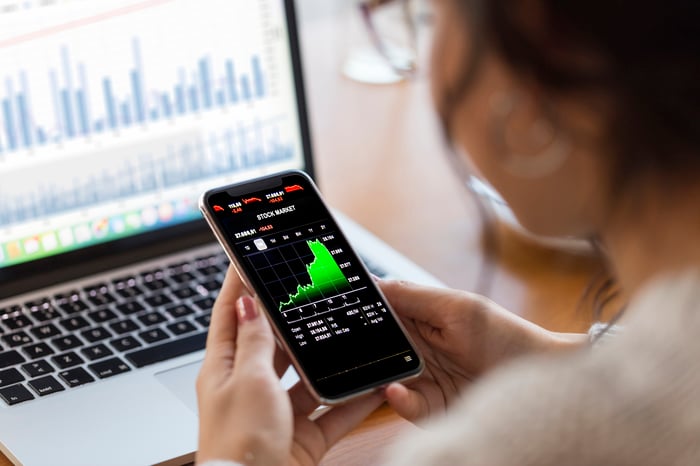Looking back more than 100 years, no asset has delivered a higher average annual return for investors than the stock market. But if we focus on just the past couple of years, cryptocurrencies have outpaced all other investment channels.
In the roughly 21 months between the March 2020 pandemic low and the end of 2021, the broad-based S&P 500 doubled in value. By comparison, the total value of all digital currencies grew by more than 1,400%. But even a 1,400% gain is peanuts next to what meme coin Shiba Inu (SHIB 1.68%) returned for its investors last year.

Shiba Inu-inspired cryptocurrencies were red-hot in 2021. Image source: Getty Images.
Shiba Inu's historic 2021 gain is being spoiled by a large retracement
Between the beginning and end of 2021, Shiba Inu tokens (SHIB) rose from $0.000000000073 to about $0.000034, according to data from CoinMarketCap.com. It might tough to tell with so many zeroes, but Shiba Inu gained a jaw-dropping 46,000,000% in 2021, and at one point had moved higher by 121,000,000%. To put this into perspective, an investment of a little over $2 at midnight on Jan. 1, 2021 would have been worth over $1 million by the end of the year.
But for as impressive as SHIB's gains were in 2021, its recent retracement is proving equally epic.
At its intra-day peak on Oct. 27, SHIB tokens were trading hands for $0.00008841, which made Shiba Inu a top-10 cryptocurrency by market value. Since then, it's been in a relatively precipitous freefall, with tokens going for $0.0000204, as of late evening Jan. 24. This works out to a decline of 77% from its peak, as well as a reduction of more than $37 billion in market value, based on a circulating supply of 549 trillion SHIB.
With a remaining market value of $11.2 billion, Shiba Inu is at real risk of falling out of the top 15 largest cryptocurrencies.
And yet, there's hope.

Image source: Getty Images.
This figure demonstrates growing conviction in Shiba Inu
While most of the optimism surrounding Shiba Inu has to do with its upcoming blockchain upgrade (which I'll touch on further in a moment), there's another figure that should give hope to investors.
A little over three months ago, cryptocurrency exchange and ecosystem Coinbase listed the median hold time for Shiba Inu at a mere six days. Given how volatile SHIB tokens were at the time (roughly a week prior to hitting its all-time intra-day high), it was clear that day-traders and momentum investors were running the show. Such short holding times suggested that there was no long-term conviction in the coin or what developers were doing behind the scenes.
But as of Jan. 24, the median hold time in Shiba Inu has catapulted to 68 days. While this is still below stalwarts like Bitcoin and Ethereum, it's actually ahead of top-10 coins like Solana and Dogecoin, which have respective median hold periods of 41 days and 56 days.
Aside from volatility dying down a bit, the launch of decentralized exchange ShibaSwap in July 2021 seems to be the biggest catalyst behind extended hold times. ShibaSwap enabled holders to stake their coins to earn passive income. Doing so requires those staking their coins to hang onto them for long periods of time. ShibaSwap looks to be creating at least a sense of conviction in SHIBs future.
As noted, Shiba Inu enthusiasts are also encouraged by the expected launch of layer-2 blockchain project Shibarium this year. This internally developed blockchain solution is expected to significantly lower transactions fees, thereby making Shiba Inu more palatable to merchants, and opening the door for non-fungible token (NFT)-based gaming in 2023.

Image source: Getty Images.
There are still plenty of reasons to be worried about SHIB
While a lengthening median hold period is a positive sign, it's important for holders and prospective buyers not to overlook the overwhelming sea of negatives.
Arguably the biggest issue for Shiba Inu continues to be its lack of clear-cut advantages and differentiation. On one hand, Shiba Inu recently surpassed 1.1 million unique wallet holders, and it's been one of the most-searched cryptocurrencies in the United States. On the other hand, a growing community isn't going to help Shiba Inu process faster or reduce its transaction costs. As it stands now, Shiba Inu is nothing more than ERC-20 token built on the Ethereum blockchain. This means it deals with the same high transaction fees and processing lags that can occasionally hit Ethereum's popular network.
To build on this point, it's also very difficult for payment coins to stand out in the cryptocurrency space. With so many intriguing blockchain projects focused on decentralized finance and/or smart contract-driven decentralized applications, there's not much to get excited about with regard to payment coins.
The worries about Shiba Inu can also be seen with its adoption. Even with hundreds of new online merchants welcoming SHIB as a form of payment over the past three months, the grand total of merchants accepting SHIB is just 607, as of Jan. 24, according to online business directory Cryptwerk. Stripping out crypto exchanges, which aren't true retailers, puts this figure well below 600, and demonstrates what little real-world utility SHIB offers.
Finally, as I've previously pointed out, history hasn't been kind to payment coins and protocol tokens following life-altering gains of 24,000% or more in a short time frame. After hitting their respective peaks, the coins I examined retraced anywhere from 93% to more than 99% within 26 months. After rocketing higher by as much as 121,000,000% in 10 months in 2021, Shiba Inu's retracement may be equally epic.





